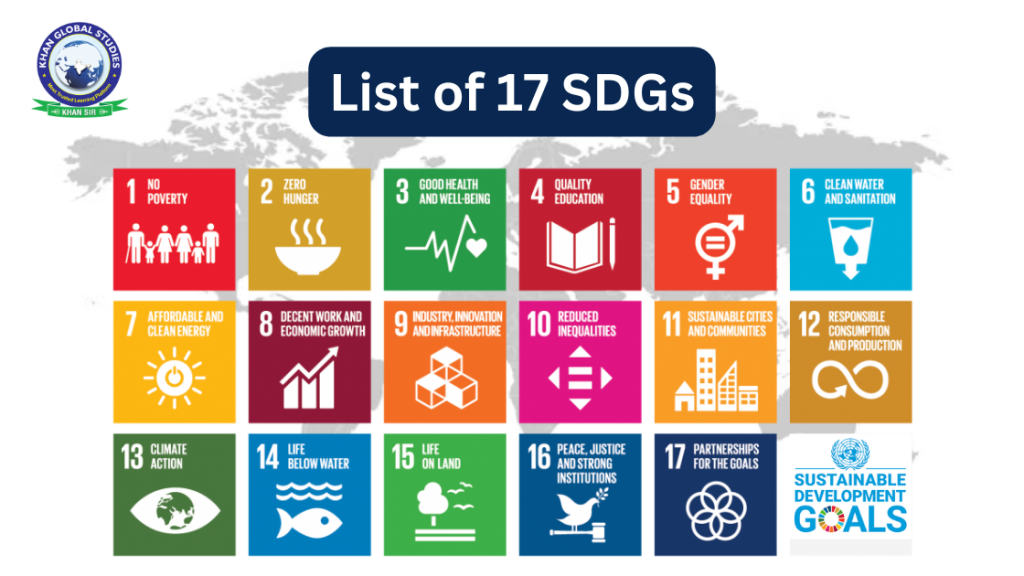
The Sustainable Development Goals (SDGs) are a set of 17 global objectives set by the United Nations (UN) to address the various social, economic and environmental challenges facing the world today. These goals provide a shared blueprint for countries to work together towards creating a more equitable, inclusive and sustainable world by 2030. As a UPSC exam aspirant, it is important to understand the importance and details of these goals, as they are an integral part of India’s development agenda and international relations.
Sustainable Development Goals Environment and Ecology are relevant under the General Studies (GS-1) Paper syllabus in the UPSC Preliminary Examination and General Studies Paper-III in the Main Examination. In recent years, UPSC has started asking direct factual and chronological questions in the preliminary exam and analytical questions in the main exam. This article on Sustainable Development Goals will help you in preparing for the UPSC exam. It is also an important topic for current affairs. In this article, we will study in detail the list of 17 SDG goals, its goals, achievements, challenges and importance.
History of Sustainable Development Goals
- The history of the Sustainable Development Goals dates back to 2000 when the United Nations adopted the Millennium Development Goals (MDGs) to address global poverty, hunger and education.
- However, the MDGs had some limitations, leading to the development of more comprehensive and universal goals. The 17 Sustainable Development Goals were introduced in 2015 to address a range of issues including climate change, economic inequality and sustainable consumption.
- The SDGs build on the successes and lessons learned from the MDGs and serve as a global commitment towards achieving a better and more sustainable future for all.
List of 17 Sustainable Development Goals
The 2030 Agenda for Sustainable Development, adopted by all UN Member States in 2015, provides a shared blueprint for peace and prosperity for people and the planet in the present and future. At its core are the 17 Sustainable Development Goals (SDGs), which are a call to urgent action by all developed and developing countries in a global partnership. Here, we have provided a list of 17 Sustainable Development Goals:
- Complete Eradication of Poverty
- End of Hunger
- Good Health and Quality of Life
- Quality Education
- Gender Equality
- Clean Water and Sanitation
- Cheap and Clean Energy
- Good Jobs and Economic Growth
- Industry, Innovation and Infrastructure
- Reduction in Inequality
- Sustainable Urban and Community Development
- Consume and Produce Responsibly
- Climate Action
- Life under Water
- Life on Land
- Peace and Justice Institute
- Collective participation in achieving Goals
In detail about Sustainable Development Goals
SDG 1: End Poverty
- The first of the 17 Sustainable Development Goals (SDGs) aims to end extreme poverty for all people everywhere by 2030.
- Poverty is a multi-dimensional issue, and the goal is to create policies that address income generation, access to basic services, and social protection.
- Sustainable Development Goals India is committed to reducing poverty by promoting social and economic inclusion through various programs and schemes.
SDG 2: End Hunger
- The other SDGs aim to end hunger, achieve food security and promote sustainable agriculture.
- Zero hunger includes increasing agricultural productivity, improving the resilience of food systems, and ensuring access to nutritious and sufficient food for all.
- India plays a key role in achieving this goal by implementing policies and programs to improve food security and agricultural sustainability.
SDG 3: Good Health and Quality of Life
- The goal of the 3rd SDG is to ensure healthy lives and promote well-being for all, regardless of age.
- This includes reducing maternal and child mortality, fighting communicable and non-communicable diseases and promoting mental health.
- India has made significant progress in improving healthcare access and outcomes, contributing to the achievement of the Sustainable Development Goals 2030.
SDG 4: Quality Education
- The 4th SDG aims to provide inclusive and equitable quality education while promoting lifelong learning opportunities for all.
- The Sustainable Development Goals focus on increasing access to quality education, improving learning outcomes and reducing gender inequalities in educational opportunities.
- India has made great progress in this area through various policies and initiatives.
SDG 5: Gender Equality
- The 5th SDG aims to achieve gender parity and empower all women and girls.
- This SDG goal addresses various forms of discrimination, violence and harmful practices against women, as well as promoting women’s participation in leadership roles and decision-making.
- India is working towards gender equality through various policies, laws and awareness campaigns.
SDG 6: Clean Water and Sanitation
- The goal of the 6th SDG is to ensure access to and sustainable management of water and sanitation for all.
- This includes improving water quality, increasing water use efficiency and protecting water-related ecosystems.
- India has taken several initiatives to improve access to clean water and sanitation, contributing to the UN Sustainable Development Goals.
SDG 7: Affordable and Clean Energy
- The 7th SDG is to ensure access to affordable, reliable, sustainable and modern energy for all.
- These include increasing the share of renewable energy, improving energy efficiency, and ensuring universal access to clean energy services.
- India has made significant progress in expanding its renewable energy potential and promoting energy efficiency.
SDG 8: Decent Work and Economic Growth
- The goal of the 8th SDG is to promote sustained, inclusive and sustainable economic growth, full and productive employment and decent work for all.
- This includes improving labor market conditions, supporting entrepreneurship and promoting innovation.
- India has implemented various policies and programs to promote economic growth, create jobs, and enhance workers’ rights.
SDG 9: Industry, Innovation and Infrastructure
- The 9th SDG focuses on building resilient infrastructure, promoting inclusive and sustainable industrialization and fostering innovation.
- This includes increasing access to information and communication technologies, supporting research and development, and promoting sustainable industrial practices.
- India is investing in infrastructure development and fostering a culture of innovation to achieve this goal.
SDG 10: Reducing Inequality
- The 10th SDG aims to reduce inequality within and between countries by promoting social, economic and political inclusion.
- This includes ensuring equal opportunities, eliminating discriminatory policies, and promoting global partnerships for development.
- India has been working to reduce income inequality and promote social inclusion through various policies and programmes.
SDG 11: Sustainable Urban and Community Development
- The 11th SDG is to make cities and human settlements inclusive, safe, resilient and sustainable.
- This includes ensuring access to affordable housing, improving urban planning and enhancing the sustainability of cities.
- India has launched several initiatives to address the challenges of urbanization and promote sustainable urban growth.
SDG 12: Consume and Produce Responsibly
- The 12th SDG aims to ensure sustainable consumption and production patterns by promoting resource efficiency, reducing waste and encouraging sustainable business practices.
- India is working to implement sustainable production and consumption practices through various policies, regulations and awareness campaigns.
SDG 13: Climate Action
- The 13th SDG focuses on taking urgent action to tackle climate change and its impacts by reducing greenhouse gas emissions, enhancing climate resilience and supporting climate adaptation efforts.
- India has been actively involved in international climate talks and has implemented various domestic initiatives to combat climate change.
SDG 14: Life Below Water
- The goal of the 14th SDG is to conserve and sustainably utilize the oceans, seas and marine resources for sustainable development.
- This includes stopping marine pollution, protecting marine ecosystems, and ensuring sustainable fisheries.
- India is working to protect its marine resources and ecosystems through various conservation and sustainable management initiatives.
SDG 15: Life on Land
- The 15th SDG promotes the protection, restoration and sustainable use of terrestrial ecosystems, halting biodiversity loss, and combating desertification.
- India has made significant efforts in promoting forest conservation, wildlife conservation and sustainable land management practices.
SDG 16: Institute for Peace and Justice
- The 16th SDG is to foster peaceful and inclusive societies, provide access to justice for all, and build effective, accountable and inclusive institutions.
- India is working towards ensuring the rule of law in its institutions, reducing corruption and increasing transparency and accountability.
SDG 17: Partnership to Achieve the Goals
- The 17th SDG stresses the importance of global partnerships to support and achieve the Sustainable Development Goals.
- This includes enhancing international cooperation, promoting sustainable development investment, and fostering multi-stakeholder partnerships.
- India is actively engaged in international partnerships and cooperation to achieve the 17 Sustainable Development Goals.
Sustainable Development Goals in India
- India is a member of the United Nations and a participant in the SDG project of the United Nations General Assembly. NITI Aayog also released the Sustainable Development Goals (SDG) India Index Baseline Report, which examines the country’s development in detail.
- Here is a breakdown of the progress India has made towards achieving these 17 Sustainable Development Goals; The Mahatma Gandhi National Rural Employment Guarantee Act (MNREGA) was implemented across the country to provide meaningful employment to unskilled workers as well as to raise their standard of living.
- The National Food Security Act was created to guarantee affordable access to food grains for all. To eliminate open defecation in India, the Government of India established its flagship programme, the Swachh Bharat Abhiyan.
- The target production of renewable energy is 175 GW. By adopting renewable energy sources like solar energy, wind energy and others, India can reduce its dependence on non-renewable resources like fossil fuels by the year 2022. Heritage City Development and Augmentation Yojana (HRIDAY) and Atal Mission for Rejuvenation and Urban Transformation (AMRUT) programs were launched to enhance the infrastructure of the country.
- After signing the Paris Agreement, India has made it clear that it is committed to tackling climate change.
Sustainable Development Goal Impact
- By 2030, the Sustainable Development Goals are expected to improve the quality of life on Earth.
- The plan was approved in 2015, and the report provided by the United Nations Development Program as of 2020 shows that many activities have been carried out for the benefit of the country and to raise the living standards of people around the world.
- The Sustainable Development Goals have resulted in a reduction in maternal mortality, which has helped reduce poverty, enhance public health, raise awareness of communicable and non-communicable diseases, as well as the importance of childhood vaccination.
- Developers are advancing medications and prioritizing mental illness as a serious concern.
- Overall, the Sustainable Development Goals aim to eliminate poverty, improve health, create jobs, empower women, reduce inequalities and achieve all the goals set by the United Nations within an allotted time of 15 years. All targets have to be achieved. To improve the quality of life.
Challenges in Sustainable Development Goals
There are some difficulties in setting the Sustainable Development Goals on a large scale. The biggest obstacles sometimes prevent the achievement of the SDGs.
- Persistent inequality in some countries is hindering the achievement of the Sustainable Development Goals.
- Youth unemployment rate.
- The rapid increase in CO2 concentrations and global warming.
- The decline of marine chemistry.
FAQs
Question: When were the 17 Sustainable Development Goals created?
Answer: The 17 Sustainable Development Goals were created and adopted by the United Nations General Assembly in September 2015 as a part of the 2030 Agenda for Sustainable Development.
Question: Who started 17 SDGs?
Answer: The 17 Sustainable Development Goals were introduced by the United Nations (UN) to build on the successes and shortcomings of the Millennium Development Goals (MDGs) and address a wide range of global issues.
Question: How many Sustainable Development Goals are there?
Answer: There are a total of 17 Sustainable Development Goals, which serve as a blueprint to achieve a better and more sustainable future for all by 2030.
Question: What is India’s role in achieving the Sustainable Development Goals?
Answer: India plays a vital role in achieving the Sustainable Development Goals, as it is home to a significant portion of the global population facing development challenges. India has adopted various policies, programs and initiatives to tackle these challenges and contribute to global progress towards the SDGs.
Question: What is the deadline for achieving Sustainable Development Goals 2030?
Answer: The deadline for achieving the 17 Sustainable Development Goals is 2030. The 2030 Agenda for Sustainable Development serves as a roadmap for countries to collectively work towards creating a more equitable, inclusive and sustainable world by the end of the 15 years (2015-2030).



